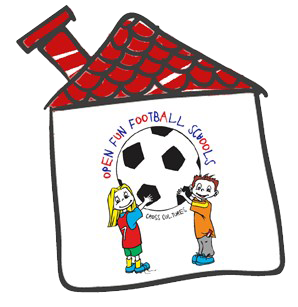Football Technique
Goalkeepers
GOALKEEPER TECHNIQUE
A goalkeeper is the key figure in a football game. It is very often the goalkeeper who gets to decide whether a team is to win or lose the game. Since the goalkeepers tasks are different from those of the players on the pitch, his/her technical and tactical skills and moral values are bound to be trained separately and in a different way. As for training children of this particular age, this specialisation, of course, does still not count. Children should develop and train as comprehensively as possible and it is therefore that they have to be introduced not only to all the techniques on the pitch, but to those on the goal as well. Children should take turns at the goalkeepers position in all games and exercises.
The bottom-line is that he who understands the roles of others is more able to understand and anticipate their behaviour. Thus, even when working with children aged 7-11, no systematic training of the goalkeepers technique is required as yet, but they need to be introduced to the most important techniques in general terms:
How to receive and catch the ball properly
How to throw properly. Rolling and in-taking
Rebounds and blocks
How to do a throw-in with the hand and with the foot. The most important goal of this training is to awaken interest in goalkeeper tasks. Enjoyment, talent, and planned and systematic training at a later point should produce a great goalkeeper.
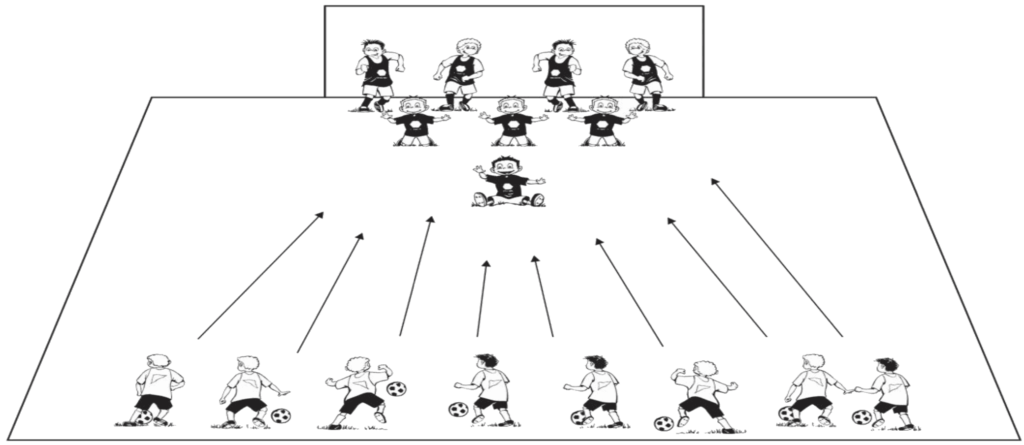
Warm-up exercises
- Every player holds his/her ball in his/her hands. Running in a circle, they are all throwing the ball in the air trying to catch it.
- Same as above, except that this time the ball is thrown at a given signal and each player has to catch the ball of another player.
- Players can also throw the ball in pairs.
Suggestion: catch the ball with your fingers and then hold it close as fast as possible. - Same as above, except that the players now roll the ball on the ground (as in bowling)
Suggestion: Hold the ball with both hands. Look at it. Keep your elbows close together. Your legs should be slightly apart and bent in the knees. Keep the ball close to your body.
The following exercises and games should be presented to the entire group. Being very relaxing and agreeable, they appeal to children, and help them develop their skills in a comprehensive and coordinated manner.
CATCHING TECHNIQUE
The basic posture and movements of a goalkeeper;
Catching a ball on the ground.
Catching a ball rolling towards the goalkeeper. The goalkeeper steps forward and throws him/herself at the ball.
Catching low balls crossed from the sides by stepping forward and throwing oneself sideways at the ball.
Catching semi-high balls.
Catching high balls (headers and shots from the side).
Boxing the ball out with one or both hands.
All these exercises are done in such a way that at first the ball is passed with the hands and then with the foot. At this station, players are offered a range of exercises for goalkeepers.

Catching: Players are in pairs; one ball
Player A passes the ball straight to player B who picks it from the ground
With his/her feet slightly spread apart, legs slightly bent in the knees
With fists wide open, fingers apart (small fingers pointing at one another).
Player A holds the ball close to himself/herself, leads it with his/her foot to the A position, and begins the game with a ground-pass to player B.
Player A plays a straight pass to player B, this time a metre or two from the side in relation to player B. Player B takes a quick step to the side and takes the ball as has been previously described.
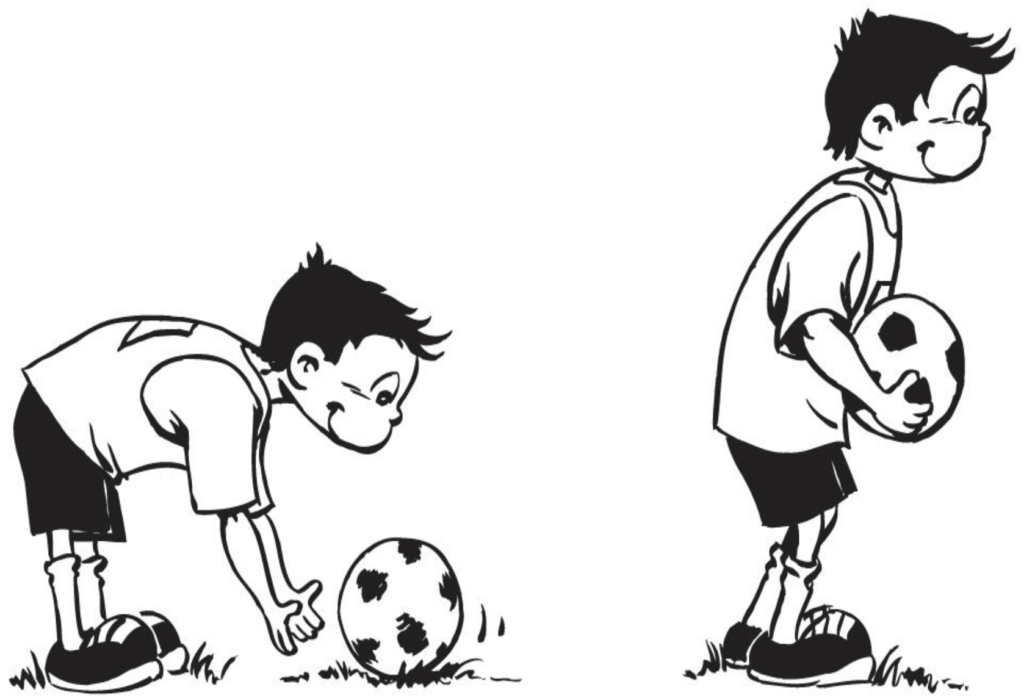
Player A throws the ball to player B at waist-height with wide open hands (fingers spread, small fingers pointed at one another). Player B runs out to receive the ball and draws it to him/herself. Lead the ball to player A and toss it to the player who had run to position B.
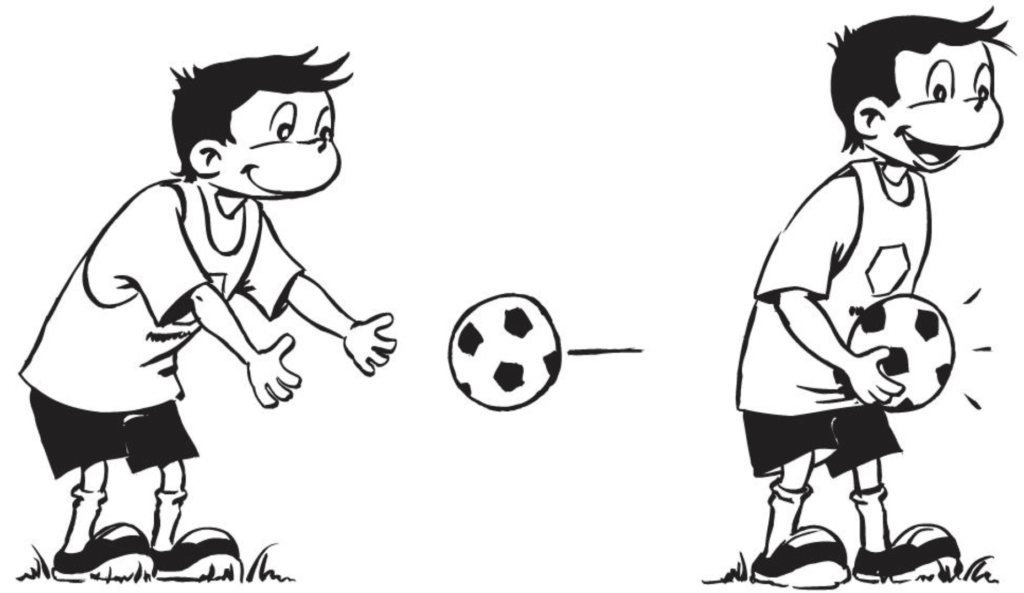
Player A tosses the ball at head-height to his/her partner. Partner’s hands reach out to get the ball, his/her fingers spread in a ball-like shape. His/her arms are stretched out, the thumbs pointed at one another. As soon as he/she touches the ball, he/she draws it to the chest. If the ball is wet, it should be caught in such a way that the hands grab the ball from underneath and press it to the chest.
Should a ball be coming in from above head-height, a goalkeeper can catch it both while jumping (with both feet) and draw it to his/her chest right away. If the ball is flying in at a reasonable height but from too short a distance, the goalkeeper then catches it by jumping forward (a short run and a one-foot jump), immediately drawing the ball to his/her chest. A wet and slippery ball is held close as soon as it is caught.
Alternate the passes continually; apply all the afore-mentioned possibilities and options.

LEARNING TO FALL
The goalkeeper is sitting on the ground, his/her legs pointed at the player. The player rolls the ball to the goalkeeper’s side. The goalkeeper rolls to the side and having caught the ball, draws it to his/her chest. His/her hands are above not below his/her body.
The exercise is repeated from a lying, kneeling, and goalkeeper’s posture, rolling the ball with the hands and with a number of different shots.

The goalkeeper is lying on his/her stomach, his/her head turned towards the partner. He/she passes the ball about 1 metre to the side in relation to the goalkeeper who tries to defend the ball from that position. His/her body is facing the opponent; his/her hands are behind the ball (fingers are spread apart).
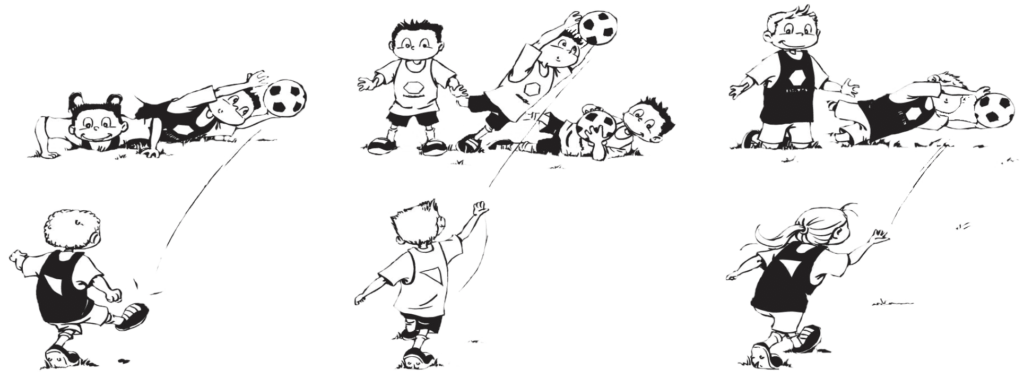
- The goalkeeper has the same posture as above, except that balls are thrown in from the side at head-height. The goalie catches the ball sideways and drags it to his/her chest rolling.
- The goalkeeper is in the same position as in the previous two exercises. His/her partner tosses the ball high to the side. The goalkeeper catches the ball stretching to the side and has to return it to the partner before he/she falls on the ground. His/her hands are now automatically stretched away from the body and this is how a goalkeeper can acquire the sense for an accurate stretch-out to the side (children should practice on a mat).
- The goalkeeper is lying on the side, face to his/her teammate. The teammate rolls the ball about 50 centimetres behind the goalkeeper’s foot. The goalkeeper stands up quickly, feet heading forward to the other side, trying to defend the shot by throwing himself/herself to the side. Having caught the ball, he/she throws it back to his/her teammate.
- The goalkeeper is kneeling down. His/her teammate rolls the balls low to his/her side. The goalkeeper stretches over his/her thighs, hips, and ribs to the side to reach the ball. One has to be careful that the arm does not end up underneath the body so as to make the fall less painful.
- The exercise is essentially the same as above, except that the balls are now thrown to the side at head- height. The goalkeeper catches the ball from the side, being careful that he/she has stretched him/herself adequately and rolling side-ways.
- The goalkeeper faces his/her teammate who is leading the ball towards him/her. At one metre distance from the goalkeeper, the player tries to direct the ball at 90 degrees to the side in relation to the goalkeeper (decide in advance which side it is going to be). The goalkeeper throws himself/herself to the side trying to take the ball off the player’s foot.
BOXING
The goalkeeper tosses the ball high in the air, clinches both his/her fists, leans his/her elbows against his/her body, and boxes the ball out to his/her partner. Fists are launched from the chest diagonally upwards, touching the ball, with arms almost fully stretched.
Same as above, except that the goalkeeper has to do a two-foot jump trying to box out the ball to his/her partner at the highest point he/she can reach.
A player tosses the ball to the goalkeeper. Depending on the situation, he/she boxes it back to the partner with both fists.
Three players, one ball. Player B tosses the ball high to player A. As an active opponent, player C stands in the front trying to cut out the goalkeeper. Player A tries to box the ball back to player B. Change positions after 15 attempts.
Same as above, except that now player B runs to his/her position after tossing the ball, and the goalkeeper is trying to box the ball out from him/her in a run.

GAMES
Divide players into two teams of eight. One team shoots at the goal defended by all the players from the other team. The team that scores the most goals out of the same number of attempts is the winner.
Options
Players are aligned in three rows; one of them is seated, the other three kneel/squat behind him/her while the remaining four players stand and defend the goal.
Four players stand in two rows, while four other players kneel in front of them and defend the goal.
All the players of the defending team are turned away from the ball. At the coachs whistle, they all turn around and defend the goal.
An 8:8 game should be played on a large goal, but it could also be organised around a German or handball goal. In that case, you should reduce the number of players to 3-6 players per team (either as a one-on-one game or as a cup). The defending team has a 4-3-1 line-up.
A Clumsy Goalkeeper
Make a goal from with cones. A player who defends it has to stand on one foot. He/she is allowed to hop around and defend the goal with the standing foot and hands. After a certain number of shots, another player is brought to defend the goal, and after all the players have taken their turns, the most successful player wins the game.
